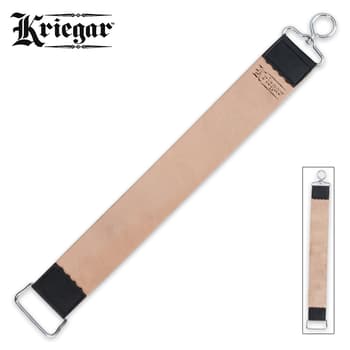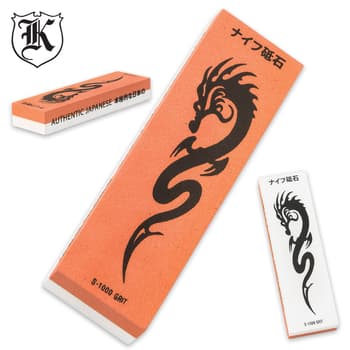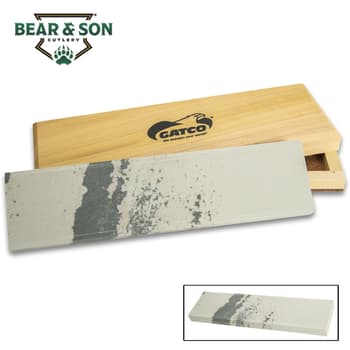How to Sharpen a Pocket Knife

By Adelia Ladson
Types of Sharpeners
When you’re looking for a means to sharpen a blade, the basic mediums used are a whetstone, a sharpening steel or a leather strop. (There are also electric sharpeners out there, but I definitely wouldn’t recommend them at all.) There’s no question that each of these mediums will sharpen your blade to some degree but not all of them will meet all of your needs in a sharpener. Here is a little information on each of them and their capabilities.
- Steel - The two kinds of steel used in knife sharpeners are diamond steel and classic metal steel. Like a whetstone, diamond steel has both a fine grit and a coarse grit. The difference is that it cuts a new edge into the blade instead of realigning the edge that’s already there. The problem is that it will change the overall shape of the blade over time. Traditional metal steel sharpeners are usually made of a high-carbon steel and can be used to keep a fine edge on an already sharp blade. Steel sharpeners are not good for using on blades that have a dull edge.
- Leather Strop - The leather strop is just what you see in films and television shows that portray an old-timey barber sharpening his razor. It’s basically, a strip of leather on one side and it’s typically suede on the other side. As with steel, it’s good for putting a fine edge on an already reasonably sharp blade. Many folks will use a sharpening compound, which is an abrasive material rubbed on the leather surface before use. I consider this a drawback because it’s another component of the sharpening process that I have to worry about finding.
- Whetstone - A whetstone can be made of a natural stone like novaculite or an artificial material like silicon carbide. They can be found in different grits and usually have a coarse side and a fine side. New particles are constantly exposed as you work the blade, so the whetstone continues to cut consistently. Lubricating it with water or oil forms a slurry with the worn material that sharpens and polishes the blade. Unlike steel or strops, whetstones can be used on any condition blade from a sharp-edged that needs a tune-up to a dull-edged that needs a rehab. They are also ideal for any blade whether it be a knife, axe or sword.
Why A Whetstone Is Better
So, why is a whetstone better to purchase to sharpen your pocket knife? Bottom line. It’s the only sharpener that you’ll need to buy for all of your blades and their individual needs. Keening up a kitchen knife or bringing back that antique pocket knife can be easily done with one sharpener. Use it to repair, sharpen and polish any blade.How to Use a Whetstone
Sharpening with a whetstone is a method that’s been used for more than a thousand years and has never changed. You either use a whetstone that you soak in water first like the Japanese water stone or you use one like the Arkansas stone that is used with mineral oil. After lubrication is taken care of, the sharpening process is the same.
- Place the whetstone on a non-slip surface with the coarser grit side up, then, place your blade flat against the stone and raise the spine to a slight angle, less than 45-degrees.
- Close one hand around the handle of the knife, place the other hand on top of the blade and push the knife down the stone in a smooth motion, going from tip to heel.
- After ten passes across the stone, lightly skim the side of the blade near the edge with your finger to feel for a burr. This is a slight raise in the metal, on the top side of the blade, that should run the entire length of the blade. It there isn’t one, continue your passes. (If your blade is double-beveled, now is the time to switch to the other side and repeat.)
- Then, move on to the finer grit on the other side of the stone and repeat the process. Rinse the blade of any debris before you repeat the sharpening process with the finer grit side of the stone. Make sure that you maintain the same angle, speed and pressure on the blade throughout the sharpening process. Your passes over the fine grit are getting rid of the burr that was raised with the coarser grit and, if you have a double-beveled knife, alternate sides of the blade with each stroke.
- When you’re done, wash your stone and wipe it with a soft cloth. Let it completely air-dry before you store it in its box. Be aware that any type of whetstone will eventually become concave with use and must be flattened again to continue to be effective in sharpening. A flattening stone can easily be purchased specifically for this purpose.
Sharpening Stone Buying Guide
What it comes down to when you’re looking to buy a whetstone is whether you want to use oil or water and how large of stone you want. Do you want it compact enough to take anywhere with you or is it going to stay in your kitchen or shop?Japanese Water Stone
When you want to get back to basics, the Japanese Water Stone is a method that’s been used for hundreds of years. The soft whetstone can absolutely be used on a pocket knife and it won’t become glazed or loaded with material from the blade it’s sharpening. New particles are constantly exposed as you work the knife, so the stone continues to cut consistently. It can be effectively lubricated with water, which forms a slurry with the worn material that sharpens and polishes the blade. Our water stone has a medium grit on one side and a fine grit on the other side. Just a note: It is a Japanese WATER stone. Never use oil or any other metal cleaner because it will absolutely ruin it.Soft Arkansas Stone
Another option in the whetstone family is the Natural Soft Arkansas Stone. The 100-percent Arkansas Stone was mined from novaculite quarries, then, carefully cut to size and skillfully finished to insure flatness. Novaculite, highly regarded by craftsmen worldwide, has a unique crystalline structure, which allows it to polish the cutting edge as it sharpens. Our Arkansas Stone comes in a custom wooden storage case. The same sharpening process is used as with the Japanese stone, except it doesn’t need to be soaked in water before you use it. It can be used dry. Be aware, that with any type of whetstone, it will eventually become concave with use and must be flattened again to continue to be effective in sharpening. A flattening stone can easily be purchased specifically for this purpose.Max Edge CLP Knife Lube
After sharpening, to keep your blade at its maximum potential, make sure that you clean and protect it, too, so that the metal stays in top condition. Our Max Edge CLP Knife Lube is a must-have for your blade maintenance routine. It penetrates and spreads along metal surfaces into every pit and crevice to lift residue away, where it can be removed. The long-lasting lubricating film dramatically reduces adhesion of sand, grit or other abrasives, which cause wear and tear on the metal of your blade. Corrosion inhibitors, in the formula, prevent the formation of rust, while the unique boundary film protects metal surfaces from moisture and other contaminants.
It’s well worth the time and effort to protect the blade of the pocket knife that you’ve invested money in!
Related Products
























